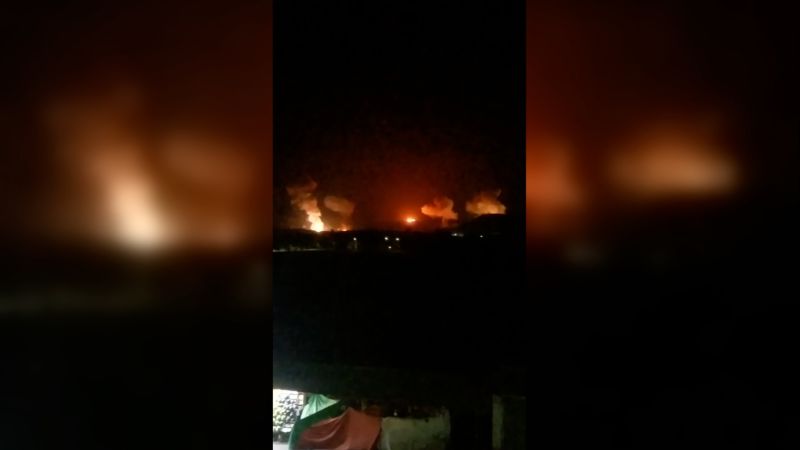Last week’s US-led airstrikes on Houthi rebel targets in Yemen destroyed less than a third of the Iranian proxy group’s overall offensive capabilities, a US official told CNN, with the group maintaining the majority of its ability to strike ships in the Red Sea.
Despite a barrage of strikes last week, including 150 precision-guided munitions fired at nearly 30 sites, the Houthis still have about three-quarters of their ability to target commercial vessels in international shipping lanes in the southern Red Sea and Gulf of Aden, the official added.
That was apparent Monday, when a Houthi missile hit a US-owned cargo ship in the Red Sea, marking what appears to be the first time the militants have successfully struck a US-owned or operated ship.
Last week’s airstrike was a success as designed – the US destroyed or damaged 93% of the targets it had selected – but some US officials privately acknowledged that it did little to set back the Houthis’ ability to continue striking international shipping.
“Message received and some degradation but we expect a response and don’t believe we have set back their military efforts substantially,” one senior US official said of the strikes.
The limited scope of last week’s operation illustrates the tightrope the Biden administration is walking in the Middle East, where a violent tit-for-tat between Iranian-backed groups and the US and Israel simmers just below the threshold of outright war.
Washington has scrupulously sought to avoid a situation in which attacks by the Houthis and other Iranian-backed groups escalate into a second front of the war between Israel and the terror group Hamas.
Since November, Houthis militants, who receive substantial arms and other support from Iran, have carried out dozens of attacks on international shipping that the group says are in retaliation for Israel’s war in Gaza. Those attacks are disrupting global trade, forcing some of the world’s largest shipping companies to avoid the waterway, instead adding thousands of miles (and potentially millions of dollars) to international shipping routes by sailing around the continent of Africa rather than going through the Suez Canal.
Senior Biden administration officials insist Friday’s operation against the Houthis was successful at its objective: degrading the group’s military capabilities.
“This wasn’t some signaling exercise,” National Security Council spokesman John Kirby said during a press gaggle Friday. “This was designed to disrupt and to degrade Houthi military capabilities.”
The dozens of targets the US struck Friday – including command and control nodes, munitions, launching systems, production facilities, and air defense radar systems – were specifically chosen to try to make it more difficult for the Houthis to strike vessels in the Red Sea, Pentagon officials have said. By design, there were few Houthi casualties.
“This was not necessarily about casualties as much as it was about degrading capability,” Lt. Gen. Douglas Sims II, director of operations for the Joint Staff, said in a briefing last week. “This was solely designed to get after the capability that is impeding … the freedom of navigation in international waters, and we feel pretty confident we did good work on that.”
And the UK, which participated in the strikes Friday, insisted they were an act of “self-defense” intended to “de-escalate tensions and to restore stability to the region.”
The New York Times first reported the damage assessments of the airstrikes.
Declassified US intelligence shows Iran has been deeply involved in coordinating the Houthi attacks on commercial and merchant ships, including by providing information about shipping vessels passing through the waterway.
US intelligence officials believe Iran is carefully calibrating its response to Israel’s war in Gaza, allowing and even encouraging its proxy groups to exact costs against Israeli and American interests in the region – while stopping short of activities that would spark a direct confrontation with Iran itself.
US officials fear one side will miscalculate, even if none of the major parties – Iran, Israel and the United States – want a wider war. This worry is particularly acute when it comes to the Houthis, which are both deeply ideological in their hatred for Israel and among the most operationally independent of the Iranian proxy groups.
Analysts believe a prolonged closure of the waterway, which connects with the Suez Canal, could snarl global supply chains and drive up the prices of manufactured goods at a crucial moment in the battle to defeat inflation. The Suez Canal accounts for 10% to 15% of world trade, which includes oil exports, and for 30% of global container shipping volumes.
“The US should look to take out as many targets as they can identify on the Yemen coast of the Sea of Aden, as they did on the Red Sea coast,” said Mick Mulroy, a former deputy assistant secretary of defense for the Middle East in the Trump administration and now an analyst for ABC News. “There should be no radar, launch or storage sites left.”
President Joe Biden on Friday said he will “not hesitate to direct further measures to protect our people and the free flow of international commerce as necessary.”
Read the full article here







